Gulf of Mexico Oil Leak - Potential to Devastate our Oceans?
The offshore rig Deepwater Horizon exploded April 20 in an oil leak that has surpassed the Exxon Valdez as the worst in U.S. history. Scientists estimate up to 20-40 million gallons have been flowing over the last five weeks but estimates vary wildly. Exxon Valdez spilled nearly 11 million gallons in 1989. A U.S. Geological Survey says scientists calculated the well has been spewing from 504,000 to over a million gallons a day but nobody knows for sure at this stage exactly how much has spilled (1). This is actually not a spill, it is a draining of a massive oil field into our oceans. It will go on for a long time, maybe several years. There are already many leaks next to the big one.
Danger of Chemical Dispersants Used
It’s not just the amount of oil spilled but the millions of gallons of toxic chemical dispersal agent Corexit 9500 which is being pumped into the leak a mile under the Gulf of Mexico waters in order to keep the full extent of this leak from the American public.
Corexit 9500 is a solvent originally developed by Exxon that is four times more toxic than oil (oil is toxic at 11 ppm, Corexit 9500 at 2.61ppm). Exxon found Corexit 9500 to be one of the most toxic dispersal agents ever developed especially as water temperatures increase. The data sheets for Corexit contain this shocker: 'No toxicity studies have been conducted on this product' -- meaning testing their safety for humans. And also 'Component substances have a potential to bioconcentrate. This is not what you want to hear about toxins being dumped in the sea by the hundreds of thousands of gallons. It means the toxins get passed on up the food chain to human eaters, not to mention the damage to aquatic life.
The U.S. Environmental Protection Agency (EPA) ordered BP to stop using Corexit 9500 but BP refused saying their only alternative to Corexit 9500 was an even more dangerous dispersal agent known as Sea Brat 4. Where Corexit 9500 degrades into an organic compound in 28 days, Sea Brat 4 which may degrade into an organic chemical Nonylphenol that is toxic to marine life and can persist for years in the environment.
I can’t help but wonder why it took the EPA so long to demand that BP adopt non-toxic methods of cleanup known to work instead? BP has refused saying it has hundreds of thousands of gallons of Corexit in supply and may not be able to find a substitute in time. However, much is unknown about the underwater use of dispersants and the risks are huge. BP said Corexit is effective, 'safe for the environment' and that other potential dispersants aren't available in sufficient quantities. Corexit is on the list of the EPA's approved dispersants, which are commonly used to break up oil during spills usually on the water's surface. But BP's use is unprecedented both in terms of the amount used and the depth at which it is being used.
Another great danger from Corexit 9500 is that as the Gulf water warms up and the dispersant goes from liquid to gas, it will be absorbed into clouds and become ‘toxic rain’ on all of eastern North America. Should a strong tropical hurricane hit the gulf with over tens of millions of gallons of Corexit 9500 sitting on top of, or near the gulf surface, the resulting ‘toxic rain’ falling upon the North American continent could cause dire health effects.
Meanwhile, the National Oceanic and Atmospheric Administration (NOAA) warned that winds forecast later this week could move the spill towards the Mississippi and Alabama coasts. An oil sheen has been seen about nine miles off the coast of Florida, with officials warning it could reach Pensacola Beach by Wednesday.
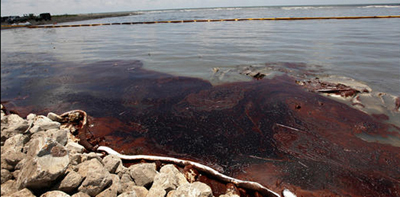
NOAA also predicted up to 14 hurricanes, of which between three to seven will be 'major' tempests, packing winds in excess of 110 mph. Powerful winds can cause 20 metre high winds above the surface. Hurricane Season started yesterday, June 1, and a hurricane could snap any of the 31,000 miles of offshore oil pipelines lying across the seafloor down to 300’ by whipping up underwater currents. Seafloor damage leading to mudslides and damaged pipes can result from hurricanes. Small leaks can be difficult to detect and repair can cost more than fixing drilling platforms. Anything less than level 3 hurricane can tear up the seafloor down to 90 meters for up to a week. (2)
Some of the suggested solutions such as setting fire to the ravaged coastline of Louisiana or flooding the area to float out the oil could ruin the marshes and do more harm than good. American scientists are warning that the damage may be impossible to repair. As for using a nuclear bomb in the area, if a nuke is detonated one mile beneath the ocean, the resulting shock wave would create the world's largest Tsunami flowing in all directions.
The most tragic thing is this disaster has occurred in the most biologically rich waters of America. Corexit 9500 coming ashore will destroy it for decades.
Some reports also hint of a secret plan to evacuate tens-of-millions of people from the Gulf of Mexico States in case the most dire of these scientific warnings start to come true.
Hidden facts
Let’s look at what mainstream media is not saying (3):
1. The leak that BP is very publicly trying to close is NOT the main leak. Marine scientists from Uni of Sth Florida’s College of Marine Science said they have discovered a massive new plume of what they believe to be oil deep beneath the Gulf, stretching 22 miles from the leaking wellhead northeast toward Mobile Bay, Ala. just beneath the surface down to about 3,300 feet, and more than 6 miles wide. They are worried these undersea plumes may be the result of the unprecedented use of chemical dispersants to break up the oil a mile undersea at the site of the leak. They said the oil has dissolved into the water and is no longer visible, meaning that the toxicity from the oil and dispersants could pose a big danger to fish larvae and filter feeders such as sperm whales, which spells disaster to the marine food chain.
2. The amount of crude spilling into the Gulf daily is not 5,000 barrels a day as reported by BP - it appears to be over 70,000 barrels, equivalent to an Exxon oil spill every single day.
3. The technology to deal with this exists and BP - along with the US government - are willfully not using it.
4. If the well is not capped it could blow wide open causing a global catastrophe. BP knows they have a ticking time bomb here as the amount of oil gushing out increases daily.
Non-Toxic Solutions
You have to ask why these are not being at least trialled until they figure out how to stop the leak.
1. Microbes (4)
2. Corncobs. (5). Recovery 1, Inc.,a Michigan company, has a patented and proven process that uses corncobs to absorb oil from oil spills like the one in the gulf. It uses no harmful/toxic chemicals and the company's efforts to offer its services have all but been ignored. They're just waiting to help.
3. Salvaging perfectly good crude oil for later sale, thereby protect marine ecosystems and wildlife.
4. 'Oil Sponge' (trademarked by Phase III, Inc.) is rated as the 'best performing' absorbent by the US Army Corp of Engineers. Oil Sponge is 100% organic, and is made from renewable resources. It is built using a microbial and nutrient package, capable of transforming oil hydrocarbons into a safe bi-product of carbon dioxide and water.
5. Mycelx - after the Exxon Valdez incident of March 1989, Mycelx of Georgia developed what looks like a paper towel to soak up to 50 times its weight in oil. And while this product is used from the Middle East to Europe to Canada it was of no interest to BP.
6. Hair is a renewable resource which naturally separates oil from water leaving large tar globs in which mushrooms can then be seeded. And as the mushrooms grow they digest the oil leaving non-toxic organics which can then be composed into soil, great for growing healthy vegetables. Lisa Gautier, president of 'Matter of Fact,' has collected 400,000 pounds of hair and stuffed it all into nylons to be used as booms near Gulf shores. This idea could have been a great boost to the U.S. economy, by creating organic compost for the millions of nutrient depleted farm acres in the world. Also there could have been a viable cottage industry of collecting hair from salons.
7. Hay, sawdust, crushed volcanic rock, kitty litter - any of which could have mulched with the oil on the surface of the Gulf waters, making for easy pick-up.
Baffling Strategies
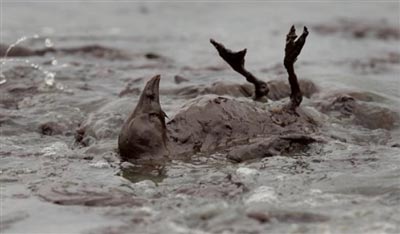
Instead of using safe, non-toxic methods of gathering up gushing oil, the oil industry (backed by the bankers) is using this extremely toxic dispersant. Why?
An interview with Phillippe Cousteau shows underwater footage of the oil mixed with dispersants sinking to the bottom out of sight (6).
BP’s so-called 'clean-up' efforts are nothing short of criminal. Where is the media outrage at this unprecedented catastrophe? Why did oil industry executives and their confederates in the Obama administration make sure that all spewing oil would sink well below the surface, or never rise to it, so it could never be vacuumed up or neutralized?
Said Alan Levine, Dept. Health and Hospitals, Louisiana “We don’t have any data or evidence on the use of these chemicals in the water. We are now basically using one of the richest ecosystems in the world as a laboratory.”
Secretary of Dept. Wildlife & Fisheries, Louisiana, Robert Barham said “We are very disappointed in the EPA and oil company executives’ approach. The federal procedures call for a consensus between federal authorities, the responsible party and the states involved. We expressed our concerns over the dispersants but they apparently decided to go ahead without us.” So instead of removing the crude oil, the EPA allowed BP to turn the Gulf into a toxic testing ground.
BP has even refused to use their own oil tankers lying in the Gulf to suck up most of the oil and salvage it for sale (as they did after a Saudi spill in the ‘90s which vacuumed up 85% of the oil).
The worst part is that these international criminals of humanity and life in the Gulf, committed their dastardly deed of deeply submerging the floating oil with an extremely dangerous chemical dispersant that would deny all marine creatures oxygen, thus killing them, and marine plant life, as major underwater currents carry the poisonous oil through-out the Gulf and into the Atlantic. Chemical dispersants are known to be 10,000 times more toxic to life than the oil itself, and their purpose is just to hide the magnitude of the blowout.
Trying to give this ecocide a positive spin, BP spokesman John Crabtree said his corporation had dropped more than 560,000 gallons of [toxic] chemical dispersants on the surface slicks and 28,700 gallons of the chemical at the subsea wellhead, 5,000 feet below sea-level. Crabtree’s justification for such an insane, criminal act was that the dispersants would drive the oil well below the water’s surface, thus keeping it away from coastal shorelines. So instead of removing the oil, BP decided to make the oil even more toxic, and drive it deep into the ocean where it can never be retrieved, but will kill all marine life in its path.
Devastation to marine wildlife
Mandy Joyce, a marine sciences professor at the University of Georgia carefully chose her words about BP’s deplorable dispersants: “Anything that requires oxygen will not be able to survive that water. The food web is going to change. You could stymie the entire production level of the Gulf of Mexico. That’s a very real possibility.”
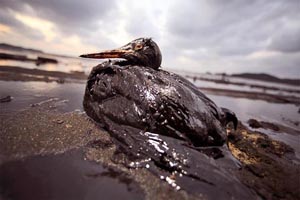
BP’s chemical dispersants contain 2-butoxyethanol, a compound that kills marine and wildlife, exactly the life our clean-up measures should try to save. BP’s chemical dispersants, currently being dropped by airplanes, break the crude oil into tiny droplets that sink well below the water’s surface, where they form a giant cloud or plume, making it impossible to gather, as is the obvious intention.
And with this poisonous plume creating a dead zone, currently estimated to be about the size of Delaware and Rhode Island combined, hidden at about 3,000 feet of water, no one can place an accurate figure on how much oil has actually gushed into the Gulf. Once this plume reaches the large, rapidly moving Loop Current, this oily cloud of death could swing toward Florida and Cuba, killing its coral reefs and marine life.
Thick oil is now coating birds and delicate wetlands along the Louisiana coast. There are nine most animals threatened by the oil spill.
1. Louisianna’s brown pelicans (just taken off the endangered list).
2. Four species of endangered sea turtles. Ten days after the spill 156 sea turtle deaths were recorded, mainly Kemp's ridley turtles, whose only breeding ground is in the Gulf region. Sea turtles are vulnerable to eating contaminated fish and ingesting/inhaling the oil when surfacing for air.
3. Herons which nest in large colonies and feed in the marshes along the coast. Also endangered plovers and terns are at grave risk.
4. Dolphins have to rise to the surface frequently to breathe. Their extra sensitive skin can suffer burns and irritation from the oil, their eyes can develop ulcers, conjunctivitis, and even blindness, and they risk inhaling the oil and its vapors, which could severely damage their lungs and airways. Ingesting the oil can lead to ulcers or internal bleeding. Oil contaminating their food supply will only exacerbate the problem down the road, and new generations may become poisoned from their mothers' milk.
5. Atlantic bluefin tuna (critically endangered due to overfishing) have peak spawning months in May and April, and the Gulf is the only documented spawning ground for the western bluefin. Unfortunately, the chemical dispersants being used on the spill only make things worse for the bluefin, as they sink the oil below the surface and into the area where delicate bluefin eggs and larvae are floating.
6. The blue crab is currently in spawning season and as the chemical dispersants break into smaller bits, the oil may accumulate in snails and mole crabs that blue crab's eat. The toxicity could have a disastrous effect on the crabs' reproduction.
7. Egrets (snowy, reddish and great egrets) feed and nest in the coastal areas now contaminated by the toxic oil.
8. Sperm Whale (endangered) 1,400 to 1,660 of which live in the Gulf of Mexico. They are at risk of oil inhalation and may pass out and drown as a result of the toxic fumes. Because sperm whales take such a long time to reach sexual maturity, if as few as three are killed from the oil spill it could be devastating to their population. Females give birth to just 3-4 calves in their entire life. Between 2000 and 2005 about 300 sperm whales were seen on a regular basis right where Deepwater Horizon sank.
9. Up to 400 endangered Manatees migrate from Florida to Louisiana waters every summer. The spreading oil spill is threatening to move into sensitive wildlife refugees and national/state parks where many endangered species live, including manatees.
The Borowitz Report exposes an email from a Goldman Sachs employee Fabrice Tourre to a girlfriend, admitting the bank ‘made a substantial financial bet against the Gulf of Mexico’ one day before the sinking of an oil rig there. How did they know? “One oil rig goes down and we’re going to be rolling in dough. Suck it fishies and birdies!” Tourre said.
An Avoidable Event
The Gulf oil spill could have been avoided in the first place if the Bush Administration had not deregulated the oil companies and required them to put in a acoustic switch system, a relay system that stops the oil leak at the source by triggering the blowout preventer. If BP wants to do business in Norway they have to use this switch but not in the U.S. It would have cost BP, who is making a record $40 billion in profits, a total of $500,000 to put this switch in but they didn't. (7)
History Repeats Itself
SHR writes on his blog on www.gazbom.blogspot.com "An oil spill happened in Alaska in 1979 on the same day that there was an oil rig burning out of control in the Gulf of Mexico and the same solutions didn't work then! You'd think there was someone around still alive who remembered this and said "Oh, we had better do something else fast!"
"Though the spill is now the biggest in U.S. history, it's not the biggest ever in the Gulf. An offshore drilling rig in Mexican waters — the Ixtoc I — blew up in June 1979, releasing 140 million gallons of oil (8). However IXTOC I happened in 50 meters of water (165 ft deep) and this one is in over 5,000 feet of water. Divers can easily reach 165 deep but at 5,000 ft everything must be done with remotely operated subs making the task of working around the well head far more difficult."
"The insane volumes of gas and oil that could be released if this thing blows apart are truly of nightmare proportions. This one isn't in the south western gulf like the IXTOC blowout was. The Gulf is sort of separated into two portions and the western side is sort of trapped, the Eastern side is not and the 'Loop current' which connects to the 'Gulf Stream' flows right through this side. It will carry the oil spillage out into the Gulf stream and all the way up the eastern seaboard all the way to the UK and Europe where it ends. There will be who knows how many cubic feet of gas released into the atmosphere and the surrounding area with an untold amount of toxins. The economic implications are dire, the fishing industry annihilated, beaches and tourism to them destroyed and who knows what other effects there will be."
"It's a very very bad disaster to say the least but THIS IS NOTHING COMPARED TO WHAT MAY HAPPEN and WILL HAPPEN if they cannot stop this thing. Nothing will stop this from blowing apart and going wide open if the rush of fluids cannot be halted, it is a CERTAINTY (11)."
Official Response
The only permanent solution is drilling a second well, but that will take a couple of months. BP plans to go ahead with that even if the top kill works and so far it hasn't. (9)
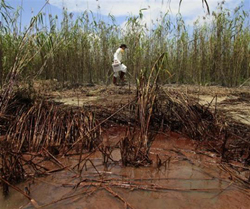
BP spokesman Steve Rinehart said “This is an all-out response and we're doing everything we can to stop this."
BP CEO Tony Hayward said ‘I think the environmental impacts of the oil spill is likely to be very, very modest”. But not to worry, they will do a very detailed environmental assessment report after the fact! And also "This is a tiny leak in a big ocean" - BP CEO.
BP has not sent down instrumentation to measure the amount of oil coming out saying "Our focus is on stopping the leak, not measuring it."
EPA Administrator Lisa Jackson told a House subcommittee on Thursday that BP used less than 12,000 gallons of dispersants on Wednesday, down from 70,000 gallons four days ago. She argued that the EPA has been aggressive in forcing BP to cut back its use of dispersants. But shouldn’t the EPA be insisting BP uses non-toxic methods?
In Washington, Minerals Management Service Director Elizabeth Birnbaum stepped down from the job. Her agency has been criticised from lawmakers of lax oversight of drilling and cozy ties with industry. It was found that between 2000 and 2008, agency staff members accepted tickets to sports events, lunches and other gifts from oil and gas companies and used government computers to view pornography.
Health Hazards
Hundreds of Gulf fishermen whose livelihoods have been destroyed by the BP-created oil catastrophe have taken jobs trying to contain the damage. As during the Valdez disaster, these workers are showing symptoms of lung damage and other internal injuries as a result of exposure to toxins.
Dispersants being dumped in large quantities into the Gulf of Mexico may cause central nervous system effects, nausea, vomiting, anesthetic or narcotic effects," and "repeated or excessive exposure to 2-butoxyethanol [an active ingredient] may cause injury to red blood cells (hemolysis), kidney or the liver." (12) Repeated or prolonged exposure to the substance can produce target organ damage and/or general deterioration of health by an accumulation in one or many human organs.
Seven cleanup crew members who reported dizziness, severe headaches and nausea while working in boats off the Louisiana coast remained hospitalized Thursday. The Coast Guard pulled commercial fishing boats from cleanup efforts in Breton Sound on Wednesday after workers first reported feeling sick.
Questions for Obama
Obama said critics failed to realize "this has been our highest priority." He announced that a new moratorium on drilling permits will be extended for six months. He also said he was suspending planned exploration drilling off the coasts of Alaska and Virginia and on 33 wells currently being drilled in the Gulf of Mexico.
Obama says he is in charge now, he knows what he is doing. But did he mention that Exxon Valdez spilled 250 THOUSAND barrels of oil? And that this hole is blowing 200,000 barrels of oil PER DAY for seven weeks, plus whatever is still gushing after the "fixit" hole does whatever it can? Did he mention the fixit hole is NOT going to stop the leak, only reduce it by some unknown amount? Did he mention that Goldman Sachs made a fortune selling short the day before the blowout of the wellhead? Did he mention all the toxic lipid destroying chemicals being dumped on the oil to keep it out of sight beneath the waves so they can lie about the amount? Did he mention that humans are made out of lipids and lipid destroying chemicals are being dumped at the bottom of the food chain of the entire planet to hide BP's evil deeds? Did he mention that 80% of the oil could be recovered if it was sucked up instead of trying to hide it under the water so it delays public outcry? Did he mention its at 170,000 psi pressure? Did he mention that this is the largest oil and gas field in the world and also blowing out natural gas in huge quantities? Did he mention it will destroy the entire Atlantic ocean?
What can we do?
A good friend of mine says that she is going to the ocean to pray for our planet. I think this is an excellent time to do this, to pray or mediate daily, visit the oceans if you can to do this. Pray for the dolphins and whales and millions of other sea creatures that are dying, and for the Atlantic Ocean which may be depleted of oxygen by this incredibly evil and unnecessary blowout of Deepwater Horizons, and the use of chemical dispersants. If you cant go to a lake or a river, I suggest we all meditate or pray over a bowl of water at least, and reaffirm our caring for our friends the dolphins, where they go, we go next.
Secondly, don't buy BP or any of their products (Castrol, AM-PM, Arco)!
Time to Change our World View
It’s time for humans to respect all living creatures and not think of them as a resource. Some say that the earth will survive, only humans will die. But don’t forget that we are in the midst of the 6th Mass Extinction. Every day we are losing over 100 species of plants and animal, species that have taken millions of years to evolve. We are destroying ALL life, not just our own. And even if we succeeded in destroying everything I doubt the earth could ever recover. Why? Because at the bottom of the food chain is plankton which makes 70-80% of the oxygen we breathe. Even plankton now has plastic in its DNA so how can we be so sure that everything will regenerate again? Plastic does not biodegrade. Can we afford to be so complacent? I don't think so. Each one of us must do everything in our power to stop the corporations destroying all life on this beautiful planet. We are all part of Earth’s enormous family (10).
Americans must all wake up and see that the oil and banking industries, both of which their lifestyles depend upon, have done more to destroy their country in the last few years than any foreign enemy could dare imagine. Other western countries should also wake up and switch allegiance from the petroleum industry to alternative power sources.
On June 2, the U.S. Attorney General announced the beginning of criminal and civil investigations into the spill.
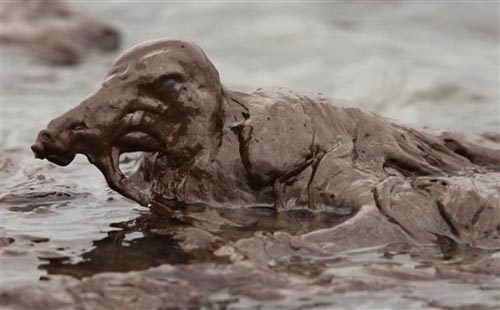
Rev 16:3 - And the second angel poured out his vial upon the sea; and it became as the blood of a dead man: and every living soul died in the sea.
References
1. http://www.google.com/hostednews/ap/article/ALeqM5i-yfHJzPLDeBIhG5JDEF6VbaPR8QD9G34HD82
2. http://www.sciencedaily.com/releases/2010/05/100526141852.htm
3. http://www.brasschecktv.com/page/855.html
4. http://www.sciencedaily.com/releases/2010/05/100526141852.htm
5. http://www.recoveryiinc.net/index.html
6. http://www.youtube.com/watch?v=7lBQkNgY3bY
7. http://www.youtube.com/watch?v=77pBcf0o444&feature=related
8. http://www.youtube.com/watch?v=x9A36A3GTcY&feature=player_embedded
9. http://www.msnbc.msn.com/id/37353392/ns/gulf_oil_spill/
10. http://www.msnbc.msn.com/id/37353392/ns/gulf_oil_spill/
11. http://gazbom.blogspot.com/2010/05/oil-spill-is-epic-disaster-of-biblical.html#ixzz0pgALROvN
12. http://www.sciencelab.com/xMSDS-2_Butoxyethanol-9923187

Recent comments